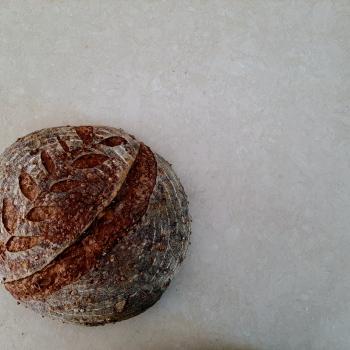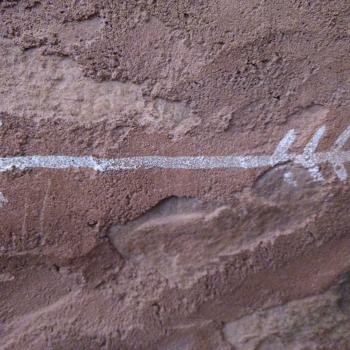
This is Transfiguration Sunday—the day when we remember and celebrate Jesus’ ascent with Peter, James, and John up Mt. Tabor to reveal himself more fully to them.1 Jesus shown bright with the glory of God. His clothes were white beyond bleaching. The voice of the Father spoke from a cloud: “This is my Son, the Beloved; listen to him!” (Mark 9:7).
The transfiguration is a sign of things to come. This is who Jesus is, and these chosen disciples get a sneak peek of eternity. The transfiguration is bookended by predictions of Jesus’ impending death, and Jesus leads his disciples down off the mountain into a situation of intense human need. In the way this scene is set in the gospels, God’s glory is refracted through the cross.
But the transfiguration is also a sign of who we will become. “All of us…are being transformed,” writes Paul in 2 Corinthians 3:18. By the Holy Spirit’s power at work within us, we’re growing into the image of Christ, “from one degree of glory to another.” John, perhaps reflecting on his encounter with Jesus’ glory on the mount of transfiguration, says that “what we will be has not yet been revealed. What we do know is this: when he is revealed, we will be like him, for we will see him as he is” (1 John 3:2). Jesus’ Sonship is unique, but we will resemble something of him into eternity.
All of this to say that following Jesus isn’t just about keeping his words and living by his ways. To follow Jesus is to be transformed, from the inside out, into what Paul calls “the full stature of Christ” (Ephesians 4:13). We model our lives on Jesus as mind and heart are transfigured into his likeness. The goal of Christian discipleship is to look like Jesus.
No doubt that’s a less than attractive outcome for many in our originality-obsessed culture where “be yourself” is likely as close to a common creed as we have. Why would anyone want to model their life on someone else–not least someone who wore sandals and robes and died on a cross 2,000 years ago? Aren’t we supposed to be looking deep within, unearthing our true selves, and living out what we discover? It’s our culture’s quest for originality.
Perhaps nowhere do we see the human quest for originality more than in funerals. A recent Wall Street Journal article describes the growing trend of custom caskets. They’re works of art meant to express the deceased’s unique character. The caskets range from the touching to the tawdry, originality expressed in the usual, pedestrian ways: air-brushed sports teams logos and hobbies. Hunting and fishing. The deceased’s favorite beer. The iconography of mass consumer culture displaces the sacred.
But even without a pricey custom casket, the human longing to be original shines through in obituaries. The longest obituaries are catalogues of accomplishments: degrees and positions and awards. Others project a simpler vision: raising families and baking bread for Sunday dinner. But old Solomon was right: whether we accomplish much or little, we die. “See, all is vanity and a chasing after the wind” (Ecclesiastes 1:14). “All go to one place; all are from the dust, and all turn to dust again” (Ecclesiastes 3:20). It’s a tad somber, but at least it has the advantage of being honest in a pull-the-bandage-off-quickly sort of way.
God bless us in our longing to leave an original mark on the world! And God have mercy on us. Ours is a longing after eternity, that desire to be a part of something bigger, to be remembered. It’s a hunger to be valued and loved. And there’s something down deep in that hunger that must be respected–maybe revered.
But somewhere near the heart of the matter lies the question of what it means to be an original human being. Here, Christian faith points toward a more interesting answer than racking up never-before-seen plaudits and ponying up for a pricey casket.
We become our most original selves as we become like Christ. There’s something about the way infinity is packed into Jesus’ human life that unfolds into the possibility of infinite human lives. From the “origin of God’s creation” flows authentic human originality (Revelation 3:14). It’s a paradox. The more we seek to imitate Christ, the more original we become.
Not original in our tastes or the teams we root for. Those are dead ends. But original and unique in our humanity: uniquely humble, uniquely good, uniquely kind. Like Barnabas in the book of Acts, we stand out for being “a good man (or woman), full of the Holy Spirit and of faith” (Acts 11:24). Chisel that on my tombstone.
I admit that I’ve been caught up in the enticing temptation to originality. For me, the quest for originality has taken the shape of a longing to say something never before said in my sermons and writing. But I’ve learned that in trying to be original, we usually just end up being weird.
Here’s where the transfiguration comes in, that lightning instant when Jesus’ glory bled through reality on the way to the cross. This is my Son, my beloved. Listen to him!
Here’s where we begin to learn the not-trying of apprenticeship to Jesus. Something happens when we stand long enough in the presence of his transfiguration light. A bit of it clings to our human skin, and we become original in the only ways that matter.
1At least according to the Revised Common Lectionary, which strangely does not jibe with the Catholic lectionary on the timing of Transfiguration Sunday.












